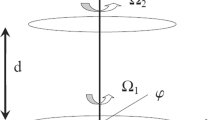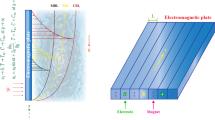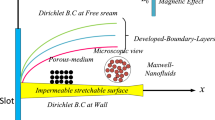Abstract
This research seeks to explore the heat shift mechanisms in a rotating system that contains a hybrid nanofluid comprising of graphene oxide and copper particles mixed with pure water, using a novel methodology. The fluid flow in a rotating system is described by mathematical equations that involve nonlinear partial differential equations (PDEs). These equations are simplified by using similarity transformations, resulting in a system of ordinary differential equations. In general, it is not feasible to find a closed-form analytical solution for nonlinear ordinary differential equations (ODEs), which implies that determining an exact mathematical expression that characterizes the behavior of the solution to such ODEs is often challenging or impossible. To that end, we have utilized the controlled learning procedure of machine learning algorithms to predict the solutions for the nonlinear nanofluid problem flowing in the rotating system. The surrogated model are developed for different cases and scenarios, to review the might of differences in various physical parameters on the profiles of the fluid. Furthermore, the solutions are supported by performing an extensive statistical analysis based on different errors. It is concluded that machine learning-based method can potentially provide insights into the underlying physics of nonlinear flow problems, which can aid in the progress of more advanced and accurate models for prognosticating the behavior of nonlinear systems.














Similar content being viewed by others
Data availability
The data that support the findings of this study are available from the corresponding author upon reasonable request.
References
Mebarek-Oudina F, Chabani I (2022) Review on nano-fluids applications and heat transfer enhancement techniques in different enclosures. J Nanofluids 11:155–168
Gao J, Hu Z, Yang Q, Liang X, Wu H (2022) Fluid flow and heat transfer in microchannel heat sinks: modelling review and recent progress. Thermal Sci Eng Progr 29:101203
Tembhare SP, Barai DP, Bhanvase BA (2022) Performance evaluation of nanofluids in solar thermal and solar photovoltaic systems: a comprehensive review. Renew Sustain Energy Rev 153:111738
Vaisi A, Javaherdeh K, Moosavi R (2022) Condensation heat transfer performance in multi-fluid compact heat exchangers with wavy and strip fins. Int J Heat Mass Transf 182:121968
Sulaiman M, Khan NA, Alshammari FS, Laouini G (2023) Performance of heat transfer in micropolar fluid with isothermal and isoflux boundary conditions using supervised neural networks. Mathematics 11:1173
Wang F et al (2023) Melting rheology of three-dimensional Maxwell nanofluid (graphene-engine-oil) flow with slip condition past a stretching surface through Darcy-Forchheimer medium. Results Phys 51:106647
Panduro EAC, Finotti F, Largiller G, Lervåg KY (2022) A review of the use of nanofluids as heat-transfer fluids in parabolic-trough collectors. Appl Therm Eng 211:118346
Alizadeh M, Dogonchi A, Ganji D (2018) Micropolar nanofluid flow and heat transfer between penetrable walls in the presence of thermal radiation and magnetic field. Case Stud Therm Eng 12:319–332
Sheikholeslami M, Hatami M, Domairry G (2015) Numerical simulation of two phase unsteady nanofluid flow and heat transfer between parallel plates in presence of time dependent magnetic field. J Taiwan Inst Chem Eng 46:43–50
Khodabandeh E, Bahiraei M, Mashayekhi R, Talebjedi B, Toghraie D (2018) Thermal performance of Ag-water nanofluid in tube equipped with novel conical strip inserts using two-phase method: geometry effects and particle migration considerations. Powder Technol 338:87–100
Adnan Ashraf W (2023) Heat transfer in tetra-nanofluid between converging/diverging channel under the influence of thermal radiations by using galerkin finite element method. Waves Random Complex Media. https://doi.org/10.1080/17455030.2023.2171154
Lund LA et al (2020) Stability analysis and multiple solution of cu-al2o3/h2o nanofluid contains hybrid nanomaterials over a shrinking surface in the presence of viscous dissipation. J Market Res 9:421–432
John Christopher A, Magesh N, Punith Gowda RJ, Naveen Kumar R, Varun Kumar RS (2021) Hybrid nanofluid flow over a stretched cylinder with the impact of homogeneous–heterogeneous reactions and Cattaneo–Christov heat flux: series solution and numerical simulation. Heat Transfer 50:3800–3821
Wang F et al (2021) Unsteady thermal transport flow of Casson nanofluids with generalized Mittag–Leffler kernel of Prabhakar’s type. J Market Res 14:1292–1300
Rajesh V, Chamkha A, Kavitha M (2020) Numerical investigation of Ag-CuO/water hybrid nanofluid flow past a moving oscillating cylinder with heat transfer. Math Methods Appl Sci
Wang F et al (2023) Natural convection in nanofluid flow with chemotaxis process over a vertically inclined heated surface. Arab J Chem 16:104599
Dogonchi AS et al (2021) Thermal and entropy analyses on buoyancy-driven flow of nanofluid inside a porous enclosure with two square cylinders: Finite element method. Case Stud Therm Eng 27:101298
Loganathan P, Sangeetha S (2022) Effect of Williamson parameter on Cu-water Williamson nanofluid over a vertical plate. Int Commun Heat Mass Transfer 137:106273
Sinha V, Kumar B, Seth G, Nandkeolyar R (2020) Outlining the impact of thermal radiation on micropolar nanofluid viscous dissipative flow: a spectral method based numerical simulation with regression analysis. In: AIP conference proceedings, vol 2253. AIP Publishing LLC, p 020024
Stajnko JK, Ravnik J, Jecl R (2017) Natural convection in a square cavity filled with a non-Darcy porous medium saturated with nanofluid by the boundary element method. J Porous Media 20:921–939
Kefayati GR (2013) Effect of a magnetic field on natural convection in an open cavity subjugated to water/alumina nanofluid using lattice boltzmann method. Int Commun Heat Mass Transfer 40:67–77
Zhou Y (2017) A sharp-interface treatment technique for two-phase flows in meshless methods. Comput Fluids 147:90–101
Alarfaj FK, Khan NA, Sulaiman M, Alomair AM (2022) Application of a machine learning algorithm for evaluation of stiff fractional modeling of polytropic gas spheres and electric circuits. Symmetry 14:2482
Khan NA, Sulaiman M, Alshammari FS (2022) Analysis of heat transmission in convective, radiative and moving rod with thermal conductivity using meta-heuristic-driven soft computing technique. Struct Multidiscip Optim 65:317
Ahmad Khan N, Sulaiman M (2022) Heat transfer and thermal conductivity of magneto micropolar fluid with thermal non-equilibrium condition passing through the vertical porous medium. Waves Random Complex Media. https://doi.org/10.1080/17455030.2022.2108161
Nonlaopon K, Khan NA, Sulaiman M, Alshammari FS, Laouini G (2022) Heat transfer analysis of nanofluid flow in a rotating system with magnetic field using an intelligent strength stochastic-driven approach. Nanomaterials 12:2273
Khan NA, Sulaiman M, Tavera Romero CA, Alshammari FS (2022) Analysis of nanofluid particles in a duct with thermal radiation by using an efficient metaheuristic-driven approach. Nanomaterials 12:637
Khan NA, Sulaiman M, Aljohani AJ, Bakar MA et al (2022) Mathematical models of CBSC over wireless channels and their analysis by using the Lenn-Woa-nm algorithm. Eng Appl Artif Intell 107:104537
Shah Z et al (2019) Hall effect on titania nanofluids thin film flow and radiative thermal behavior with different base fluids on an inclined rotating surface. AIP Adv 9:055113
Shah Z et al (2017) Effects of hall current on steady three dimensional non-Newtonian nanofluid in a rotating frame with Brownian motion and thermophoresis effects. J Eng Technol 6:e296
Wang F et al (2023) Comparative analysis between copper ethylene–glycol and copper-iron oxide ethylene–glycol nanoparticles both experiencing Coriolis force, velocity and temperature jump. Case Stud Therm Eng 47:103028
Kántor G, Papageorgakis C, Niarchos V (2022) Solving conformal field theories with artificial intelligence. Phys Rev Lett 128:041601
Tang H et al (2021) An exploratory study on machine learning to couple numerical solutions of partial differential equations. Commun Nonlinear Sci Numer Simul 97:105729
Wu M, Zhang J, Huang Z, Li X, Dong Y (2023) Numerical solutions of wavelet neural networks for fractional differential equations. Math Methods Appl Sci 46:3031–3044
Qian K, Liao AS, Gu S, Webster-Wood VA, Zhang YJ (2023) Biomimetic IGA neuron growth modeling with neurite morphometric features and CNN-based prediction. Comput Methods Appl Mech Eng 417:116213
Sulaiman M, Fazal F, Alshammari FS, Laouini G (2023) Dynamics of bioconvection radiative MHD flow with gyrotactic microorganisms: an intelligent computation approach. Waves Random Complex Media. https://doi.org/10.1080/17455030.2023.2182456
Khan NA, Alshammari FS, Tavera Romero CA, Sulaiman M, Mirjalili S (2021) An optimistic solver for the mathematical model of the flow of Johnson Segalman fluid on the surface of an infinitely long vertical cylinder. Materials 14:7798
Li A, Zhang YJ (2023) Isogeometric analysis-based physics-informed graph neural network for studying traffic jam in neurons. Comput Methods Appl Mech Eng 403:115757
Li A, Barati Farimani A, Zhang YJ (2021) Deep learning of material transport in complex neurite networks. Sci Rep 11:11280
Author information
Authors and Affiliations
Contributions
All authors equally contributed this manuscript and approved the final version.
Corresponding author
Ethics declarations
Conflict of interest
Authors of this manuscript declare that they have no Conflict of interest regarding this manuscript.
Additional information
Publisher's Note
Springer Nature remains neutral with regard to jurisdictional claims in published maps and institutional affiliations.
Rights and permissions
Springer Nature or its licensor (e.g. a society or other partner) holds exclusive rights to this article under a publishing agreement with the author(s) or other rightsholder(s); author self-archiving of the accepted manuscript version of this article is solely governed by the terms of such publishing agreement and applicable law.
About this article
Cite this article
Khan, N.A., Sulaiman, M. & Lu, B. Predictive insights into nonlinear nanofluid flow in rotating systems: a machine learning approach. Engineering with Computers (2024). https://doi.org/10.1007/s00366-024-01993-1
Received:
Accepted:
Published:
DOI: https://doi.org/10.1007/s00366-024-01993-1




